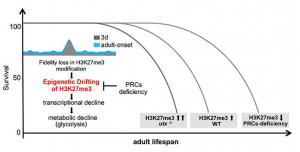Epigenetic Drift of H3K27me3 in Aging Links Glycolysis to Healthy Longevity
Preprint posted on 15 January 2018 https://www.biorxiv.org/content/early/2018/01/15/247726
Article now published in eLife at http://dx.doi.org/10.7554/eLife.35368
Do epigenetic changes contribute to aging? A recent preprint shows that histone H3K27 methylation is a critical determinant of longevity in flies.
Selected by Sammi (Shuang Wang)Categories: molecular biology
Summary of the preprint
In the current study, Ma et al. combined genome-wide histone profiling with powerful fly genetics to identify age-associated changes in H3K27me3 as a critical determinant of longevity and organismal fitness. The authors first made the interesting observation that, just like in mammals, aging flies display an overall increase in H3K27me3, especially in the regions that have low methylation levels in younger animals. Using genetically modified flies with altered levels of H3K27me3, the authors demonstrated that the level of H3K27me3 was inversely proportional to longevity, providing strong support for the global increase in H3K27me3 as a driver of the aging process. Furthermore, the authors discovered that increased H3K27me3 contributes to aging through a selective inhibition of glycolytic genes, which in turn altered glucose metabolism and redox state that accelerated aging. The authors’ findings are summarized in the diagram below extracted from figure 7 of their preprint.
Why this preprint caught my eye
Epigenetic changes have long been associated with aging; in fact, DNA methylation profiling provides one of the best predictors of biological age in both human and mouse (Hannum et al. ; Stubbs et al. 2017). Whether such epigenetic changes represent a driver or merely a passenger of the aging process remains unclear. Taking a genomic approach that linked global changes in H3K27me3 patterning to glycolysis, this study unequivocally established age-related changes in the epigenome, which is observed across the phylogenetic tree, as a driver of the aging process.
Open questions
Several interesting questions arise from this study: Why do global changes in H3K27me3 selectively target glycolytic and redox genes, yet spare the more canonical polycomb targets such as the Hox gene family? Can EZH2 (a H3K27 methyltransferase) inhibitors that are currently in clinical trials increase longevity by preventing age-associated changes in H3K27me3 and glycolytic genes? Considering that similar shifts in metabolism occur in cancer, how might results from this aging study contribute to our understanding of the link between epigenetics, aging, and cancer?

( Reproduced from Ma et al.)
Hannum G, Guinney J, Zhao L, Zhang L, Hughes G, Sadda S, Klotzle B, Bibikova M, Fan J-B, Gao Y et al. Genome-wide Methylation Profiles Reveal Quantitative Views of Human Aging Rates. Molecular Cell 49: 359-367.
Stubbs TM, Bonder MJ, Stark A-K, Krueger F, von Meyenn F, Stegle O, Reik W. 2017. Multi-tissue DNA methylation age predictor in mouse. Genome Biology 18: 68.
Posted on: 19 February 2018 , updated on: 20 February 2018
Read preprintSign up to customise the site to your preferences and to receive alerts
Register hereAlso in the molecular biology category:
Fetal brain response to maternal inflammation requires microglia
Clusters of lineage-specific genes are anchored by ZNF274 in repressive perinucleolar compartments
Nanos2+ cells give rise to germline and somatic lineages in the sea anemone Nematostella vectensis
preLists in the molecular biology category:
BSCB-Biochemical Society 2024 Cell Migration meeting
This preList features preprints that were discussed and presented during the BSCB-Biochemical Society 2024 Cell Migration meeting in Birmingham, UK in April 2024. Kindly put together by Sara Morais da Silva, Reviews Editor at Journal of Cell Science.
| List by | Reinier Prosee |
‘In preprints’ from Development 2022-2023
A list of the preprints featured in Development's 'In preprints' articles between 2022-2023
| List by | Alex Eve, Katherine Brown |
CSHL 87th Symposium: Stem Cells
Preprints mentioned by speakers at the #CSHLsymp23
| List by | Alex Eve |
9th International Symposium on the Biology of Vertebrate Sex Determination
This preList contains preprints discussed during the 9th International Symposium on the Biology of Vertebrate Sex Determination. This conference was held in Kona, Hawaii from April 17th to 21st 2023.
| List by | Martin Estermann |
Alumni picks – preLights 5th Birthday
This preList contains preprints that were picked and highlighted by preLights Alumni - an initiative that was set up to mark preLights 5th birthday. More entries will follow throughout February and March 2023.
| List by | Sergio Menchero et al. |
CellBio 2022 – An ASCB/EMBO Meeting
This preLists features preprints that were discussed and presented during the CellBio 2022 meeting in Washington, DC in December 2022.
| List by | Nadja Hümpfer et al. |
EMBL Synthetic Morphogenesis: From Gene Circuits to Tissue Architecture (2021)
A list of preprints mentioned at the #EESmorphoG virtual meeting in 2021.
| List by | Alex Eve |
FENS 2020
A collection of preprints presented during the virtual meeting of the Federation of European Neuroscience Societies (FENS) in 2020
| List by | Ana Dorrego-Rivas |
ECFG15 – Fungal biology
Preprints presented at 15th European Conference on Fungal Genetics 17-20 February 2020 Rome
| List by | Hiral Shah |
ASCB EMBO Annual Meeting 2019
A collection of preprints presented at the 2019 ASCB EMBO Meeting in Washington, DC (December 7-11)
| List by | Madhuja Samaddar et al. |
Lung Disease and Regeneration
This preprint list compiles highlights from the field of lung biology.
| List by | Rob Hynds |
MitoList
This list of preprints is focused on work expanding our knowledge on mitochondria in any organism, tissue or cell type, from the normal biology to the pathology.
| List by | Sandra Franco Iborra |











 (No Ratings Yet)
(No Ratings Yet)